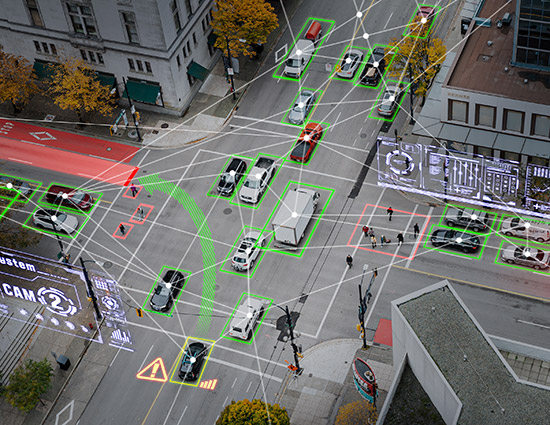Let me start with the ten trillion-dollar question: how to go about fixing the global labor shortage. Boston Consulting Group says that the workforce crisis puts $10 trillion at risk by 2030, an extraordinary number on any terms. Right now, we’re staring down the barrel of a perfect storm whipped up by a lack of labor, supply chain problems and a global boom in e-commerce that is causing obstacles for businesses that deliver goods to retail stores and homes. Particularly in the firing line are warehouses and distribution centers (DCs) – nodal agencies that distribute goods. So how are the industries responding?
The rate of innovation and adoption of automation and autonomous systems in non-manufacturing segments is growing faster and investments are pouring in. AMRs (Automated Mobile Robots) are working alongside people in warehouses and helping in improving productivity. Is this enough? Yes and no. Yes, it’s showing businesses that automation can deliver, but not nearly enough that it is solving the operational challenges at scale and certainly not for the storms ahead.
What’s the challenge? Scalability! Even though technological breakthroughs are being made, the lack of scalable solutions is making it tougher for ‘adoption at scale’. What comes to your mind when you think of products that have scaled well and moved millions to embrace innovation? Well, for me it’s Ford’s Model T, Amazon’s Echo and Apple’s iPhone. You get the picture now, right?
The scalability of an automation solution essentially breaks down into three areas: reliable, adaptable, and usable. Recently, companies like Walmart, FedEx, DHL and Target have emphasized in many forums the need for automation solutions to work at the scale needed to address their operational and business problems.
Generally, design and engineering teams do a great job in building a scalable product. But the challenge here is proving the viability of new technologies, such as real-time environmental perception, navigation, CBRS/5G wireless, edge AI and so on in unstructured environments – while also trying to build a reliable product at the same time. This is no easy feat for any R&D team.
Warehouse automation: innovators must take a system thinking approach to scale up successfully
Autonomous systems in warehouses
Amazon Prime’s same-day delivery feature has set the pace for the e-commerce market and consumer expectations. As a result, major brands and shippers want to bring in automation that can work round the clock in their warehouses and DCs. If these systems malfunction or break down, they are going to materially impact their ability to fulfill delivery and cause revenue and business loss. For larger operators, the losses will percolate throughout their network. Last but never least is ensuring the safety of associates when autonomous systems are swarming around warehouses. My colleague Stuart Watson has explored how developers can build-in safety during the development of AI based autonomous systems.
Lack of real-world data is the biggest challenge presented to reliable and safe autonomous systems. If you are building a car, there are billions, if not more, of data points about road surface conditions throughout the world. It’s not the same case with autonomous mobile robots. We don’t have enough data about real-world conditions in warehouses. Here I’m talking about people and material crisscrossing during regular or peak seasons, the light conditions during day or night in the yards, and visibility during the sun, snow or foggy conditions, amongst others.
To manage this challenge, we advise our clients to leverage synthetic data and simulation strategy early in the product development cycle. Increasingly, a large percentage of every dollar you pay for a product or service is spent on software and algorithms. As algorithms take the center stage of AI, machine learning and deep learning techniques, a lot of data is also essential to deliver a reliable and stable product function. As real-world data is difficult to acquire, we have a choice between longer and expensive R&D cycles, or smartly augmenting real-world data with synthetic data and leverage simulation for building reliable products.
AMRs in warehouses
I’m reminded of the quote by Leon C. Megginson (Louisiana State University 1963) who paraphrased Darwin when he said: “It is not only the strongest or the most intelligent who will survive but those who can also best manage change.” For me this is true of humans and just as true for autonomous mobile robots in warehouses. Warehouse operations are fast-paced, agile and dynamic.
A last-minute change of delivery schedule, the types of boxes and bags handled by a robotic manipulator, the variability in operating environments between docking bays and much more are all just routine in the day in the life of a warehouse associate. How do we expect robots to survive this?
We aren’t talking about bringing in a Terminator robot that would ‘handle-all’. The reality is far from that. We already have dedicated automation and autonomous systems to handle these different tasks. But when variations come within those tasks these systems fall short of adapting to them. This is a challenge for large warehouse owners who have invested hundreds of thousands or millions of dollars to bring in cutting-edge technology.
We need smarter and contextually aware machines that can adapt their functions to changes in the environment. This is beyond just having smart sensors and controllers. AI-driven systems can help in determining the optimal set of actions through evaluating complexities in the present environment. At Cambridge Consultants, we developed a platform called ABE (Autonomic Behavioral Engine), which emulates human-like intelligence in dynamic environments.
In the current avatar, ABE continuously scans for dynamic obstacles in an airport and leverages reinforcement learning-based AI to enable the system to take the best course of action to successfully navigate around moving people. We are hopeful that in the future, systems like ABE can enable AGVs (Autonomous Guided Vehicles). AMRs and trailer loading/unloading systems to become adaptable in their deployments.
We’ve been talking to several end-users and technology companies, and the number one issue that warehouses are dreading is creating ‘islands of automation’. This would be a huge showstopper for the scalability of automation solutions in the logistics industry.
Interoperability is crucial
The topic of Interoperability was discussed heavily at the AMR&L event in Memphis back in October. FedEx organized a demonstration of an early version during the event, while some companies presented a great vision of future warehouse operations on the stage. Getting autonomous and automation systems to interoperate with each other is essential to spur adoption. It’s time to grow the whole pie now!
Warehouses need a unified ability to manage their automation assets. It will help them with seamless data flow between their business and ensure that operations and resources are agile and nimble enough for market needs. The software that brings all automation systems together is critical.
The software architecture should enable the integration of different kinds of data such as state (location, charge, utilization and so on), operational (task type, progress, exceptions), and business (SKU, customer, truck, etc.). Building intelligent digital services is a key challenge as we move from the physical world to the digital world. It’s vital then, that due thought is given to how we integrate the physical and digital world.
Another important aspect of usability is user-centered design, which is something of an afterthought with engineers sometimes. Collaborative robotics (cobotics) has been around us for a while. However, as the robots are getting out of the cages, I think it is time for designers to think deeply about how machines interact with humans. Imagine a scenario where a warehouse associate is doing the last hour of their shift on a Friday and is being tasked to work with AMR to finish an urgent task. The least AMR could do is cheer them up with something like a “hey buddy, we are almost there – TGIF” message.
Ensuring these autonomous systems are leveraging design principles based on Human Machine Understanding would be helpful to in winning the engagement and confidence of users. And as a final point – remember that products like the Model T, the iPhone and Echo became phenomenal successes because innovation spanned product, user engagement and business models. All that helped them scale their success! Email me if you’d like to continue the conversation, I’d love to hear from you.





